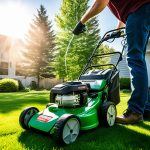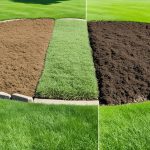As summer approaches, many homeowners are looking to revive their lawns after the winter months. Preparing your garden space properly can make a significant difference in how it looks and performs during the warmer season. A well-maintained lawn creates an attractive outdoor living area and can increase your property’s curb appeal.
Getting your lawn ready for summer doesn’t need to be complicated or time-consuming. With the right techniques and a bit of planning, you can transform even the most neglected grass into a lush green carpet. These simple steps can help you achieve professional-looking results without hiring expensive landscaping services.
1) Rake thoroughly to remove dead grass and debris
Starting your lawn care routine with a good raking session is a simple yet effective step. Dead grass, leaves, and other debris can build up on your lawn over winter, creating what’s known as thatch. This layer prevents water, air, and nutrients from reaching the soil and grass roots.
A firm raking helps to remove this thatch layer and allows your grass to breathe again. Use a leaf rake for larger debris first, then follow with a dethatching rake to get deeper into the grass. The best time to do this is when the soil is dry but not too hard.
You might be surprised by how much material comes up during a thorough raking. This debris can be added to your compost pile rather than sent to landfill. The raking process also helps to identify any bare patches that may need reseeding later.
For larger lawns, consider breaking the job into sections over several days. This makes the task more manageable and reduces strain on your body. Remember to wear gloves to protect your hands from blisters during the raking process.
2) Apply a high-quality lawn feed
Feeding your lawn with a premium product like Scotts Turf Builder can make a significant difference to its health and appearance. The right fertiliser provides essential nutrients that grass needs to grow thick and green, ready for summer activities.
Spring is the perfect time to apply lawn feed as the grass begins its active growth phase. Scotts Turf Builder is formulated to release nutrients gradually, feeding the lawn consistently for up to eight weeks after application.
Before applying, ensure your lawn is moist but not wet. Use a spreader for even distribution according to the package instructions. The correct application rate is important to prevent burning the grass.
Water the lawn lightly after applying the feed to help activate the product. This helps the nutrients reach the root zone where they’re most needed.
Regular feeding every 6-8 weeks throughout the growing season will help maintain a lush lawn. For best results, avoid applying during drought conditions or when temperatures are consistently above 25°C.
3) Aerate the soil using a garden fork or aerator shoes
Compacted soil prevents water, air and nutrients from reaching grass roots. Aerating your lawn creates small holes that allow these essential elements to penetrate deeply, promoting healthier grass growth.
You can aerate your lawn with simple tools like a garden fork or specialised aerator shoes. With a garden fork, push it about 10-15cm into the soil and gently rock it back and forth before removing it. Repeat this process across your entire lawn, spacing holes about 15cm apart.
Aerator shoes offer a more convenient option for smaller lawns. These sandal-like devices strap over your regular footwear and feature spikes on the bottom. Simply walk across your lawn wearing them to create the needed holes.
The best time to aerate is during spring or autumn when soil is moist but not waterlogged. This makes penetration easier and reduces stress on your lawn.
Clay-heavy soils benefit from yearly aeration, while sandy soils might need it less frequently. Pay special attention to high-traffic areas where soil compaction is often worse.
After aerating, apply fertiliser and water your lawn thoroughly to help it recover and make the most of its improved access to nutrients.
4) Overseed bare patches with a hardy grass seed mix
Bare patches in your lawn can be an eyesore and create opportunities for weeds to take hold. Overseeding these areas is a simple solution that can restore your lawn’s uniform appearance before summer arrives.
Choose a grass seed mix suited to your climate and lawn conditions. For UK lawns, look for mixes containing perennial ryegrass, fescue, or bent grass varieties that handle British weather well.
Start by lightly raking the bare area to break up the soil surface. This helps the seeds make good contact with the soil and improves germination rates.
Apply the seed according to the package directions, usually at a rate of about 35g per square metre. Spread the seeds evenly across the bare patch, extending slightly into the surrounding healthy grass.
After seeding, cover with a thin layer of topsoil or compost—about 5mm deep. This protects the seeds and provides nutrients as they grow.
Water the newly seeded areas lightly but frequently to keep the soil consistently moist. Avoid heavy watering that might wash away seeds.
New grass should begin to appear within 7-14 days, depending on conditions. Keep foot traffic away from these areas until the new grass is at least 5cm high and has been mowed once or twice.
5) Mow the lawn to a height of 2.5–3.5 cm
Keeping your lawn at the correct height is essential for summer health. When cutting grass to a height of 2.5–3.5 cm, you provide the perfect balance between neat appearance and plant vitality.
Regular mowing at this height stops weeds from establishing while allowing grass roots to grow strong. A common mistake is cutting too short, which stresses grass plants and makes them more likely to suffer during hot weather.
Set your mower blades to the correct height before you begin. Most modern mowers have simple adjustment levers to help you achieve the perfect cut height.
For best results, never remove more than one-third of the grass height in a single mowing session. If your lawn has grown very tall, gradually reduce the height over several cuts rather than all at once.
The best time to mow is when the grass is dry and during cooler parts of the day. This prevents clumping and reduces stress on both the lawn and the mower.
6) Water early in the morning to reduce evaporation
Smart watering schedules make a big difference in lawn health during summer. The best time to water your lawn is early morning, preferably between 4-10 am.
Morning watering gives grass time to absorb moisture before the day heats up. When you water during midday, up to 30% of water can be lost to evaporation before it reaches the roots.
Early morning also means less wind, which helps water land where intended rather than blowing away. The morning dew on grass actually helps water absorption as well, making your watering more effective.
Consistent morning watering reduces the risk of fungal diseases too. Evening watering leaves moisture on grass blades overnight, creating perfect conditions for fungus and mould to develop.
Set up automatic timers if you find it hard to water early. Many affordable timer systems attach directly to outdoor taps and can be programmed to start exactly when needed.
7) Top dress with a thin layer of compost or topsoil
Adding a thin layer of compost or topsoil to your lawn is an excellent way to improve soil health and boost grass growth. This technique, known as top dressing, helps level uneven areas and provides essential nutrients directly to the root zone.
For best results, apply a 6-12mm layer of fine compost or quality topsoil evenly across your lawn. Too thick a layer can smother grass, while too thin won’t provide enough benefits.
Spread the material using a large rake or shovel, working in small sections to ensure even coverage. After spreading, use the back of a rake to work the material down between the grass blades to soil level.
Water the lawn thoroughly after top dressing to help settle the material. This practice works particularly well when combined with aeration, as the compost can fill the holes and improve soil structure.
Spring and early summer are ideal times for top dressing, giving your lawn plenty of time to absorb the nutrients before peak growing season. For established lawns, once per year is typically sufficient.
8) Control moss with ferrous sulphate treatment
Moss can be a stubborn problem in lawns, especially in shaded or damp areas. Ferrous sulphate is an effective treatment that kills moss while adding iron to your soil, which benefits grass growth.
For best results, apply ferrous sulphate in spring when moss is actively growing. Mix the product according to package instructions, typically 60-85g per square metre, and apply using a watering can with a rose attachment or a sprayer.
The moss will turn black within 24-48 hours after application, indicating it’s dying. Once the moss has blackened completely, rake it out of your lawn to prevent it from decomposing and adding nutrients that might encourage more moss growth.
After removing the dead moss, overseed bare patches to encourage grass to fill in these areas. Remember that ferrous sulphate is a treatment, not a permanent solution to moss problems.
Address the underlying causes of moss growth for long-term control. Improve drainage, reduce shade where possible, and aerate compacted soil to create conditions that favour grass over moss.
9) Edge neatly to define lawn borders
A well-edged lawn creates clean, distinct boundaries between your grass and garden beds, pathways or driveways. This simple step makes a remarkable difference in the overall appearance of your garden, giving it a professional, well-maintained look.
To edge effectively, you’ll need either a manual edging tool, a powered edge trimmer, or a spade with a sharp blade. Begin by marking out your desired border line using string or a garden hose as a guide.
Cut vertically along this line, creating a small trench about 5-7 cm deep. This creates a clear division that stops grass from spreading into unwanted areas and makes mowing easier.
For existing borders that need refreshing, trim away any grass that has crept over the edge. Regular maintenance every 2-3 weeks during summer will keep borders looking sharp.
Consider adding physical barriers like stone, brick or metal edging for a more permanent solution. These materials not only look attractive but also reduce the frequency of re-edging.
After edging, sweep or rake away any loose soil or grass clippings to leave a tidy finish. This small detail makes a big difference to the final look.
10) Remove weeds by hand or use selective herbicides
Weeds compete with your grass for nutrients, water and sunlight, making them unwelcome guests in any well-maintained lawn. Hand-pulling is an effective method for dealing with isolated weeds or small patches.
For best results, pull weeds after rain when the soil is soft, making it easier to remove the entire root system. Grasp the weed firmly at its base and pull straight up to extract as much of the root as possible.
Selective herbicides offer another solution for more widespread weed problems. These products target specific weed types whilst leaving your grass unharmed.
Before applying any herbicide, identify the weeds in your lawn to select the most appropriate product. Always read and follow the manufacturer’s instructions carefully regarding application rates and safety precautions.
Apply herbicides on calm days to prevent drift onto desirable plants. Many products work best when applied to actively growing weeds on dry days with no rain forecast for at least 24 hours.
Regular lawn maintenance, including proper mowing and fertilising, will help create conditions where grass thrives and weeds struggle to establish themselves.
Understanding Your Lawn’s Summer Needs
Summer brings unique challenges to lawn care, requiring specific attention to heat stress and water management. Preparing your lawn properly can make the difference between a lush green space and a patchy brown disappointment.
The Impact of Summer Weather on Turf Health
Hot temperatures place significant stress on grass plants, affecting their growth and appearance. When temperatures rise above 30°C, many common lawn grasses slow their growth or enter a dormant state to conserve resources.
Water requirements increase dramatically during warm weather. Most lawns need about 2.5 cm of water weekly during summer, ideally delivered in fewer, deeper waterings rather than frequent light sprinklings.
Sunlight patterns change in summer, with some areas receiving intense direct sun for longer periods. This can lead to dry patches in previously healthy sections of your lawn.
Root development often suffers in extreme heat. Shallow root systems make grass less resilient and more vulnerable to disease and pest attacks.
Common Summer Lawn Challenges
Drought stress appears as bluish-grey colouring, footprints remaining visible after walking, and eventual browning if not addressed. Installing a rain gauge helps monitor natural precipitation levels.
Pest activity increases in warm weather. Look for:
- Brown patches that expand daily
- Chewed grass blades
- Small insects visible when parting the grass
Fungal diseases thrive in summer humidity. Red thread, dollar spot and brown patch typically appear as circular damaged areas. Proper mowing height (usually 5-7.5 cm) helps prevent these issues.
Weed competition intensifies as certain species like crabgrass and dandelions flourish in warm conditions. Early morning inspection can help identify problem areas before weeds become established.
Long-Term Lawn Maintenance Strategies
Maintaining a healthy lawn requires consistent care throughout the seasons. Regular attention to pest prevention and smart watering habits will ensure your grass stays lush and vibrant year after year.
Prevention of Pests and Diseases
Early identification is key to managing lawn pests and diseases. Check your lawn weekly for brown patches, unusual growth patterns or insect activity.
When you spot problems, avoid broad-spectrum pesticides that might harm beneficial organisms. Instead, try targeted treatments for specific issues or natural deterrents like nematodes for grub control.
Consider these preventative measures:
- Maintain proper mowing height (typically 5-7.5 cm)
- Remove thatch regularly
- Improve soil drainage in wet areas
- Choose grass varieties resistant to common local diseases
Healthy soil creates a robust defence system. Test your soil pH every 2-3 years and adjust as needed. Most grasses prefer slightly acidic conditions (pH 6.0-7.0). Regular aeration helps prevent compaction that can stress grass and create entry points for disease.
Sustainable Watering Practices
Water deeply but infrequently to encourage deep root growth. This approach creates drought-resistant lawns that require less maintenance over time.
The best watering time is early morning (5-9 am) when evaporation rates are low. Aim for 2.5-4 cm of water per week, adjusting for rainfall and temperature.
Water-saving equipment worth considering:
- Soaker hoses that deliver water directly to soil
- Rain barrels to collect and reuse rainwater
- Smart controllers that adjust watering based on weather conditions
- Moisture sensors that prevent overwatering
Lawn clippings left after mowing act as natural mulch, helping soil retain moisture. For established lawns, slight drought stress actually encourages deeper root growth—wait until grass shows signs of wilting before watering again.





